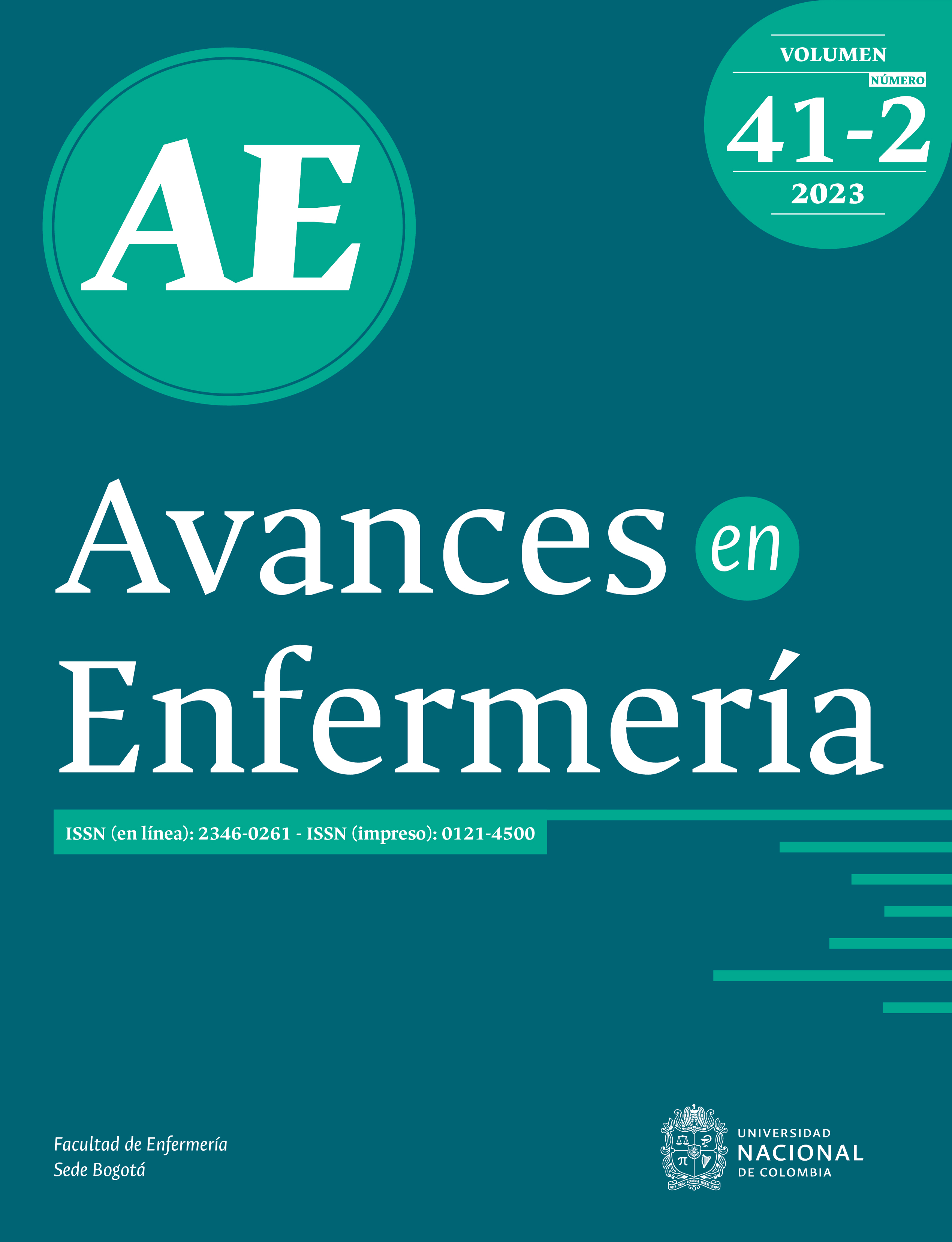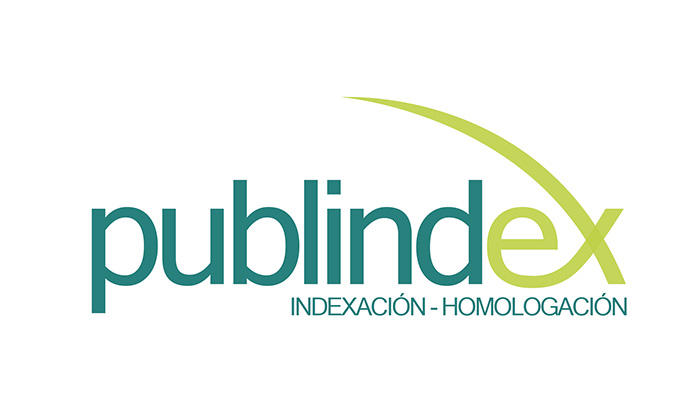Propiedades psicométricas del Índice de Bienestar General en mujeres gestantes colombianas
Psychometric properties of the General Well-being Index in Colombian pregnant women
Propriedades psicométricas do Índice de Bem-Estar Geral em gestantes colombianas
DOI:
https://doi.org/10.15446/av.enferm.v41n2.105068Keywords:
Depresión, Mujeres Embarazadas, Estudio de Validación, Reproducibilidad de los Resultados (es)Depression, Pregnant Women, Validation Study, Reproducibility of Results (en)
Depressão, Gestantes, Estudo de Validação, Reprodutibilidade dos Testes (pt)
Downloads
Objetivo: explorar la estructura y consistencia interna del Índice de Bienestar General de la Organización Mundial de la Salud (WHO-5) en mujeres gestantes del departamento del Magdalena, Colombia.
Materiales y métodos: participaron 200 mujeres entre 14 y 44 años (M = 23,52; DE = 5,93) y período de gestación entre 5 y 39 semanas (M = 21,71; DE =1 0,44); 75,5 % vivía en zona urbana, 91,5 % tenía bajos ingresos económicos, 81 % tenía pareja, 34,5 % había alcanzado el nivel de educación superior y 77,5 % se encontraba sin empleo. Los procedimientos estadísticos se realizaron con el software Jamovi. La consistencia interna se calculó mediante los coeficientes alfa de Cronbach y omega de McDonald, y se aplicó un análisis factorial confirmatorio (AFC) para corroborar la dimensionalidad de la escala.
Resultados: el WHO-5 mostró valores alfa de Cronbach y omega de McDonald de 0,81. El AFC evidenció una estructura de un solo factor con indicadores adecuados de bondad de ajuste (X2 = 17,40, gl = 5, p < 0,004; RMSEA = 0,111 [IC 95 % = 0,057-0,171]; SRMR = 0,037; CFI = 0,961; TLI = 0,921).
Conclusiones: el WHO-5 presenta estructura unifactorial y adecuada consistencia interna para evaluar los síntomas depresivos en mujeres gestantes de Colombia. Es recomendable explorar el desempeño psicométrico del WHO-5 en otros contextos.
Objective: to explore the structure and internal consistency of the General Well-Being Index (WHO-5) in pregnant women in the department of Magdalena, Colombia.
Materials and methods: Two hundred women aged 14-44 (M = 23.52; SD = 5.93) with a gestation period between 5 and 39 weeks (M = 21.71; SD = 10.44) participated of this study; 75.5% lived in urban areas, 91.5% reported low income, 81% had a partner, 34.5% had attained higher education, and 77.5% were unemployed at the time of the study. Statistical procedures were performed using Jamovi software. Internal consistency was calculated using Cronbach’s alpha and McDonald’s Omega coefficients, and a confirmatory factor analysis (CFA) was applied to corroborate the dimensionality of the scale.
Results: The WHO-5 showed Cronbach’s alpha and McDonald’s omega values of 0.81. The CFA reported a single factor structure with adequate goodness-of-fit indicators (X2 = 17.40, gl = 5, p < 0.004; RMSEA = 0.111 [95% CI = 0.057-0.171]; SRMR = 0.037; CFI = 0.961; TLI = 0.921).
Conclusions: The WHO-5 presents a unifactorial structure and adequate internal consistency to assess depressive symptoms among pregnant women in Colombia. It is suggested to explore the psychometric performance of the WBI in other contexts.
Objetivo: explorar a estrutura e a consistência interna do Índice de Bem-Estar Geral da Organização Mundial da Saúde (OMS-5) em gestantes do departamento de Magdalena, Colômbia.
Materiais e métodos: participaram 200 mulheres entre 14 e 44 anos (M = 23,52; DP = 5,93) e gestação entre 5 e 39 semanas (M = 21,71; DP = 10,44); 75,5% residiam na zona urbana, 91,5% tinham baixa renda, 81% tinham um companheiro, 34,5% tinham nível superior completo e 77,5% estavam desempregadas. Os procedimentos estatísticos foram realizados com o software Jamovi. A consistência interna foi calculada por meio dos coeficientes alfa de Cronbach e ômega de McDonald, e uma análise fatorial confirmatória (AFC) foi aplicada para corroborar a dimensionalidade da escala.
Resultados: O OMS-5 apresentou valores de alfa de Cronbach e ômega de McDonald de 0,81. A AFC mostrou uma estrutura de fator único com indicadores adequados de bondade de ajuste (X2 = 17,40, gl = 5, p < 0,004; RMSEA = 0,111 [95% CI = 0,057-0,171]; SRMR = 0,037; CFI = 0,961; TLI = 0,921).
Conclusões: o OMS-5 apresenta uma estrutura unifatorial e consistência interna adequada para avaliar os sintomas depressivos em mulheres grávidas na Colômbia. É recomendável explorar o desempenho psicométrico do OMS-5 em outros contextos.
References
(1) Sartorius N. Depression and diabetes. Dialogues Clin Neurosci. 2018;20(1):47-52. http://doi.org/10.31887/dcns.2018.20.1/nsartorius
(2) Ministerio de Salud y Protección Social. Encuesta Nacional de Salud Mental Tomo 1. Bogotá: Ministerio de Salud y Protección Social; 2015. https://bit.ly/3OfGOOh
(3) Departamento Administrativo Nacional de Estadística (DANE). Salud mental en Colombia: un análisis de los efectos de la pandemia. Bogotá: DANE ; 2021. https://bit.ly/46ZpDb4
(4) Gaynes BN; Lux L; Gartlehner G; Asher G; Forman-Hoffman V; Green J et al. Defining treatment-resistant depression. Depress Anxiety. 2020;37(2):134-145. http://doi.org/10.1002/da.22968
(5) Johnston KM; Powell LC; Anderson IM; Szabo S; Cline S. The burden of treatment-resistant depression: A systematic review of the economic and quality of life literature. J Affect Disord. 2019;242:195-210. http://doi.org/10.1016/j.jad.2018.06.045
(6) De Zwart PL; Jeronimus BF; de Jonge P. Empirical evidence for definitions of episode, remission, recovery, relapse and recurrence in depression: A systematic review. Epidemiol Psychiatr Sci. 2019;28(5):544-562. http://doi.org/10.1017/S2045796018000227
(7) Van Niel MS; Payne JL. Perinatal depression: A review. Cleve Clin J Med. 2020;87(5):273-277. http://doi.org/10.3949/ccjm.87a.19054
(8) Guimarães FJ; Santos FJS; Leite AFB; De Holanda VR; De Sousa GS; Perrelli JGA. Enfermedad mental en mujeres embarazadas. Enferm Glob. 2019;18(1):499-534. http://doi.org/10.6018/eglobal.18.1.328331
(9) Dagher RK; Bruckheim HE; Colpe LJ; Edwards E; White DB. Perinatal depression: Challenges and opportunities. J Women's Health. 2021;30(2):154-159. http://doi.org/10.1089/jwh.2020.8862
(10) O’Connor A; Geraghty S; Doleman G; De Leo A. Suicidal ideation in the perinatal period: A systematic review. Ment Health Prev. 2018;12:67-75. http://doi.org/10.1016/j.mhp.2018.10.002
(11) Gao M; Hu J; Yang L; Ding N; Wei X; Li L et al. Association of sleep quality during pregnancy with stress and depression: A prospective birth cohort study in China. BMC Pregnancy Childbirth. 2019;19:444. http://doi.org/10.1186/s12884-019-2583-1
(12) Effati-Daryani F; Zarei S; Mohammadi A; Hemmati E; Yngyknd SG; Mirghafourvand M. Depression, stress, anxiety and their predictors in Iranian pregnant women during the outbreak of COVID -19. BMC Psychol. 2020;8:99. http://doi.org/10.1186/s40359-020-00464-8
(13) Vieira ES; Caldeira NT; Eugênio DS; Lucca MM; Silva IA. Breastfeeding self-efficacy and postpartum depression: A cohort study. Rev Lat Am Enfermagem. 2018;26:e3035. http://doi.org/10.1590/1518-8345.2110.3035
(14) Kalmbach DA; Cheng P; Ong JC; Ciesla JA; Kingsberg SA; Sangha R et al. Depression and suicidal ideation in pregnancy: Exploring relationships with insomnia, short sleep, and nocturnal rumination. Sleep Med. 2020;65:62-73. http://doi.org/10.1016/j.sleep.2019.07.010
(15) Martínez-Paredes JF; Jácome-Pérez N. Depression in pregnancy. Rev Colomb Psiquiatr. 2019;48(1):58-65. http://doi.org/10.1016/j.rcpeng.2017.07.002
(16) Vázquez MB; Míguez MC. Validation of the Edinburgh postnatal depression scale as a screening tool for depression in Spanish pregnant women. J Affect Disord. 2019;246:515-521. http://doi.org/10.1016/j.jad.2018.12.075
(17) Cosma A; Költő A; Chzhen Y; Kleszczewska D; Kalman M; Martin G. Measurement invariance of the WHO-5 well-Being Index: Evidence from 15 European countries. Int J Environ Res Public Health. 2022;19(16):9798. http://doi.org/10.3390/ijerph19169798
(18) Organización Mundial de la Salud (OMS). Wellbeing measures in primary health care: care/the DepCare Project: Report on a WHO meeting: Stockholm, Sweden, 12-13 February. WHO Regional Office for Europe; 1998. https://apps.who.int/iris/handle/10665/349766
(19) Topp CW; Østergaard SD; Søndergaard S; Bech P. The WHO-5 Well-Being Index: A systematic review of the literature. Psychother Psychosom. 2015;84(3):167-176. http://doi.org/10.1159/000376585
(20) Downs A; Boucher LA; Campbell DG; Polyakov A. Using the WHO–5 Well-Being Index to identify college students at risk for mental health problems. J Coll Stud Dev. 2017;58(1):113-117. http://doi.org/10.1353/csd.2017.0008
(21) Eser E; Çevik C; Baydur H; Güneş S; Esgin TA; Öztekin ÇS et al. Reliability and validity of the Turkish version of the WHO-5, in adults and older adults for its use in primary care settings. Prim Health Care Res Dev. 2019;20:e100. http://doi.org/10.1017/S1463423619000343
(22) Mortazavi F; Mousavi SA; Chaman R; Khosravi A. Validation of the World Health Organization-5 Well-Being Index; assessment of maternal well-being and its associated factors. Turk Psikiyatri Derg. 2015;26(1):48-55. https://pubmed.ncbi.nlm.nih.gov/25742037/
(23) Do HP; Baker PRA; Van Vo T; Luong-Thanh BY; Nguyen LH; Valdebenito S et al. Brief screening for maternal mental health in Vietnam: Measures of positive wellbeing and perceived stress predict prenatal and postnatal depression. J. Affect. Disord. 2021;3:100047. http://doi.org/10.1016/j.jadr.2020.100047
(24) Mortazavi F; Mehrabadi M; KiaeeTabar R. Pregnant women’s well-being and worry during the COVID -19 pandemic: A cross-sectional study. BMC Pregnancy Childbirth. 2021;21:59. http://doi.org/10.1186/s12884-021-03548-4
(25) Wit L; Jelsma JGM; van Poppel MNM; Bogaerts A; Simmons D; Desoye G et al. Physical activity, depressed mood and pregnancy worries in European obese pregnant women: results from the DALI study. BMC Pregnancy Childbirth. 2015;15:158.
http://doi.org/10.1186/s12884-015-0595-z
(26) Van der Zwan JE; de Vente W; Koot HM; Huizink AC. Validation of the Dutch version of the Pregnancy Experience Scale. Midwifery. 2017;50:16-20. http://doi.org/10.1016/j.midw.2017.03.018
(27) Campo-Arias A; Miranda-Tapia GA; Cogollo Z; Herazo E. Reproducibilidad del Índice de Bienestar General (WHO-5 WBI) en estudiantes adolescentes. Salud Uninorte. 2015;31(1):18-24. http://doi.org/10.14482/sun.31.1.5493
(28) Espitia-Correa JL; Caballero-Domínguez CC; Campo-Arias A. Desempeño psicométrico del Índice de Bienestar General WHO-5 en
adolescentes escolarizados. Tesis Psicol. 2020;15(2):184-196. http://doi.org/10.37511/tesis.v15n2a10
(29) Simancas-Pallares M; Díaz-Cárdenas S; Barbosa-Gómez P; Buendía-Vergara M; Arévalo-Tovar L. Propiedades psicométricas del Índice de Bienestar General-5 de la Organización Mundial de la Salud en pacientes parcialmente edéntulos. Rev Fac Med. 2016;64(4):701-705. http://doi.org/10.15446/revfacmed.v64n4.52235
(30) Wacholder S; Armstrong B; Hartge P. Validation studies using an alloyed gold standard. Am J Epidemiol. 1993;137(11):1251-1258. http://doi.org/10.1093/oxfordjournals.aje.a116627
(31) Clark LA; Watson D. Constructing validity: Basic issues in objective scale development. In: Kazdin AE (ed). Methodological issues and
strategies in clinical research (4th ed). Washington: American Psychological Association; 2016. p. 187-203. https://doi.org/10.1037/14805-012
(32) Kline P. A handbook of test construction: Introduction to psychometric design. New York: Methuen; 1986.
(33) Markham A; Buchanan E. Research ethics in context: Decision-making in digital research. In: Schäfer MT; van Es K (eds.). The Datafied Society: Studying culture through data. Amsterdam: Amsterdam University Press; 2017. p. 201-209. http://doi.org/10.25969/MEDIAREP/12445
(34) Goodman LA. Kolmogorov-Smirnov tests for psychological research. Psychol Bull. 1954;51(2):160-168. http://doi.org/10.1037/h0060275
(35) Mann HB; Whitney DR. On a test of whether one of two random variables is stochastically larger than the other. Ann Math Statist. 1947;18(1):50-60. https://doi.org/10.1214/aoms/1177730491
(36) Kruskal WH; Wallis WA. Use of ranks in one-criterion variance analysis. J Am Stat Assoc. 1952;47(260):583-621. http://doi.org/10.1080/01621459.1952.10483441
(37) Mishra P; Pandey C; Singh U; Gupta A; Sahu C; Keshri A. Descriptive statistics and normality tests for statistical data. Ann Card Anaesth. 2019;22(1):67-72. http://doi.org/10.4103/aca.aca_157_18
(38) Tavakol M; Wetzel A. Factor Analysis: A means for theory and instrument development in support of construct validity. Int J Med Educ. 2020;11:245–247. http://doi.org/10.5116/ijme.5f96.0f4a
(39) Schreiber JB. Issues and recommendations for exploratory factor analysis and principal component analysis. Res Social Adm Pharm. 2021;17(5):1004-1011. http://doi.org/10.1016/j.sapharm.2020.07.027
(40) Hair J; Anderson R; Tatham R; Black W. Análisis Multivariante. Madrid: Prentice-Hall; 1999.
(41) Bartlett MS. Tests of significance in factor analysis. Br J Stat Psychol. 1950;3(2):77-85. http://doi.org/10.1111/j.2044-8317.1950.tb00285.x
(42) Kaiser HF. An index of factorial simplicity. Psychometrika. 1974;39:31-36. http://doi.org/10.1007/bf02291575
(43) Williams B; Onsman A; Brown T. Exploratory factor analysis: A five-step guide for novices. Australas J Paramed. 2010;8:1-13. http://doi.org/10.33151/ajp.8.3.93
(44) Hu L; Bentler PM. Cutoff criteria for fit indexes in covariance structure analysis: Conventional criteria versus new alternatives.
Struct Equ Modeling. 1999;6(1):1-55. http://doi.org/10.1080/10705519909540118
(45) Cronbach LJ. Coefficient alpha and the internal structure of tests. Psychometrika. 1951;16:297-334. http://doi.org/10.1007/bf02310555
(46) McDonald RP. The theoretical foundations of principal factor analysis, canonical factor analysis, and alpha factor analysis. Br J Math Stat Psychol. 1970;23(1):1-21. http://doi.org/10.1111/j.2044-8317.1970.tb00432.x
(47) Taber KS. The use of Cronbach’s alpha when developing and reporting research instruments in science education. Res Sci Educ. 2018;48:1273-1296. http://doi.org/10.1007/s11165-016-9602-2
(48) Hayes AF; Coutts JJ. Use omega rather than Cronbach’s alpha for estimating reliability. But Commun Methods Meas. 2020;14(1):1-24. http://doi.org/10.1080/19312458.2020.1718629
(49) The JAMOVI Project. JAMOVI . (Version 2.3) [Computer Software]; 2022. https://www.jamovi.org
(50) World Medical Association Declaration of Helsinki: Ethical Principles for Medical Research Involving Human Subjects. JAMA. 2013;310(20):2191-2194. https://doi.org/10.1001/jama.2013.281053
(51) Ministerio de Salud y Protección Social de la República de Colombia. Resolución 8430 de 1993; (Oct. 4, 1993). https://bit.ly/46KxusT
(52) Bonniga R; Saraswathi AB. Literature review of Cronbach alpha coefficient and McDonald’s Omega Coefficient. Eur. J. Mol. Clin. Med. 2020;7(6):2943-2949. https://papers.ssrn.com/sol3/papers.cfm?abstract_id=4443362
(53) Goodboy AK; Martin MM. Omega over alpha for reliability estimation of unidimensional communication measures. Ann Int Commun Assoc. 2020;44(4):422-439. http://doi.org/10.1080/23808985.2020.1846135
(54) Marsh HW; Hau KT; Wen Z. In search of golden rules: Comment on hypothesis-testing approaches to setting cutoff values for fit indexes and dangers in overgeneralizing Hu and Bentler’s (1999) findings. Struct Equ Modeling. 2004;11(3):320-341. http://doi.org/10.1207/s15328007sem1103_2
(55) Yanikkerem E; Ay S; Piro N. Planned and unplanned pregnancy: Effects on health practice and depression during pregnancy. J Obstet Gynaecol Res. 2013;39(1):180-187. http://doi.org/10.1111/j.1447-0756.2012.01958.x
(56) Karaçam Z; Önel K; Gerçek E. Effects of unplanned pregnancy on maternal health in Turkey. Midwifery. 2011;27(2):288-293. http://doi.org/10.1016/j.midw.2009.07.006
(57) Gray JB. The social support process in unplanned pregnancy. J Commun Health. 2014;7(2):137-146. http://doi.org/10.1179/1753807614y.0000000054
(58) Knekta E; Runyon C; Eddy S. One size doesn’t fit all: Using factor analysis to gather validity evidence when using surveys in your research. CBE Life Sci Educ. 2019;18(1):1-17. http://doi.org/10.1187/cbe.18-04-0064
(59) Bliese PD; Maltarich MA; Hendricks JL; Hofmann DA; Adler AB. Improving the measurement of group-level constructs by optimizing between-group differentiation. J Appl Psychol. 2019;104(2):293-302. http://doi.org/10.1037/apl0000349
(60) Kyriazos TA. Applied psychometrics: Sample size and sample power considerations in factor analysis (EFA, CFA) and SEM in general. Psychology. 2018;9(8):2207-2230. http://doi.org/10.4236/psych.2018.98126
How to Cite
VANCOUVER
ACM
ACS
APA
ABNT
Chicago
Harvard
IEEE
MLA
Turabian
Download Citation
License
Copyright (c) 2023 Yeison David Gallo-Barrera , Laura Vanessa Fuentes Vanegas, Ediltrudis Ramos-De La Cruz

This work is licensed under a Creative Commons Attribution-NonCommercial 4.0 International License.
All articles published by Avances en Enfermería are licensed under the Creative Commons Attribution 4.0 International License. Starting 2020, we added the CC-BY-NC recognition to the license, which means anyone is allowed to copy, redistribute, remix, transmit and transform our contents with non-commercial purposes, and although new works must adequately cite the original work and source and also pursue non-commercial purposes, users do not have to license derivative works under the same terms.































